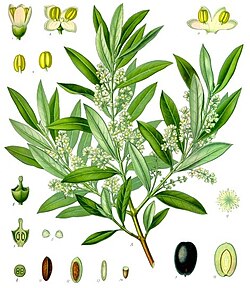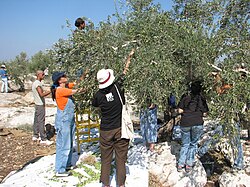Olive (fruit)
The olive (Olea europaea) is the fruit of the olive tree. It is an important food crop in countries around the Mediterranean Sea, and places with a Mediterranean climate.
| Olive | |
|---|---|

| |
| 19th century illustration | |
| Scientific classification | |
| Kingdom: | |
| Division: | |
| Class: | |
| Order: | |
| Family: | |
| Genus: | |
| Binomial name | |
| Olea europaea | |
It is a healthy food but rather fatty. It has olive oil, one of the fattiest cooking oils in use, even more than palm, canola and other vegetable oils. Olive oil is the juice made by crushing olives. It is considered to be healthier alternative to sunflower oil.
In Roman literature, the olive branch is used as a symbol of peace: "extending the olive branch". In Christianity, too, it is seen as a symbol of peace, because according to the Bible, a dove brought an olive branch to Noah to show that the flood was over. Many writers and illustrators use olive branches around text to give it greater artistic credit (a similar effect is achieved with wheat).
The raw olives are very bitter. They are "cured" mostly by bacterial fermentation. Later they may be alternately washed with water and packed with salt. The procedures vary a lot, and different varieties of olives get different treatment. The bitter chemical oleuropein, a phenol compound, has to be broken down or removed. This is what the curing process does. Even so, olives still often do have a rather bitter taste. There is a variety called "Kalamata" which grows around kalamata region in Greece. The olives which are eaten raw and have a very pleasant taste.
Olives are mainly known as a fruit but some people identify them as a vegetable.
Olive (fruit) Media
Specimen of Olea europaea sylvestris as bonsai. These trees grow wild in the mountains of the Spanish island of Mallorca and are valued for their tiny leaves and rough bark. This tree won 1st prize in the broadleaf evergreen category in the 2024 edition of the Unión del Bonsái Español (UBE) exhibition in Aranjuez, Spain.
Greek vase showing two bearded men and a youth gathering olives from a tree, by the Antimenes Painter (c. 520–510 BC)
Woman with red hair wearing a garland of olives, from Herculaneum, sometime before the city's destruction in 79 AD
Vat room used for curing at Graber Olive House









